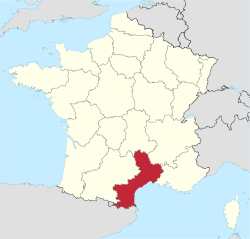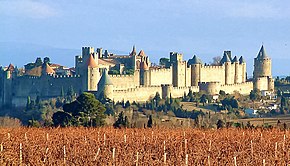| no flag on Wikidata: | |
| no coat of arms on Wikidata: | |
| Languedoc-Roussillon region | |
| Capital | Montpellier |
|---|---|
| Residents | 2.700.266 |
| other value for residents on Wikidata: 2729721 | |
| surface | 27,376 km² |
| other value for area on Wikidata: 23376 | |
| no tourist info on Wikidata: | |
| location | |
 | |
The region Languedoc-Roussillon located in the south Of France.
Departments

- Languedoc
- Aude (Carcassonne) - on the western Mediterranean coast north of the Pyrenees
- Gard (Nîmes)
- Herault (Montpellier)
- Lozère (Mende)
- Roussillon
places

- Montpellier - Capital of the region, charming and lively old town and magnificent gardens
- Aigues-Mortes - Port city with medieval fortifications, center of traditional bullfighting
- Carcassonne - The fortress city with cult character
- Collioure - Town on the Côte Vermeille, a favorite place for Fauvist artists
- Narbonne - one of the oldest cities in France, was already the capital of southern Gaul during the Roman Empire
- Nîmes - with an impressive legacy of monuments from Roman times.
- Perpignan - Capital of Roussillon, the French part of Catalonia, maintains its own cultural heritage
- Uzes - Former capital of the "first duchy of France", beautiful old town with medieval monuments
Other goals
- Cote Vermeille - the “bright red coast” on the Mediterranean, from Plage Racou south of Argelès-sur-Mer to the Spanish border
- Costa Brava - starts on the French side south of Port-Vendres.
background

In the 12th to 14th centuries, Languedoc and Roussillon were strongholds of a religious movement known as Cathars or Albigensians (they never called themselves that, but simply referred to themselves as "Christians" or "good Christians"), which the Catholic Church considered heretical were viewed. At first they enjoyed the protection of the local nobility and the goodwill of large sections of the population. Pope Innocent III However, in 1209 called for a crusade against the group, which was led with great brutality. Various castle ruins on high cliffs are evidence of this time.
The Canal du Midi was built between 1667 and 1694. It connects the Garonne near Toulouse via Carcassonne and Béziers with the Mediterranean near Sète. With a few dozen locks and a lift and a highest point of 189 m above sea level, the canal was a technical masterpiece. The canal has been part of the UNESCO world cultural heritage.
language
The traditional language of the region is Occitan (sometimes synonymous with Provencal), which occurs in various dialects. The name of the Languedoc region is also derived from this language: Langue d'Oc means "language of òc" - óc is the Occitan word for "yes". (In contrast, linguists understand the northern and central French dialects as langues d'oïl together because oïl the old French word for "yes" was, in modern times it has become the commonly known oui developed). Occitan was an important written language in the Middle Ages. In the course of the centralization of France, however, it was pushed back more and more from standard French - the sole official and school language - was. Today only a minority speaks Occitan in everyday life, the elderly more than the younger, the rural population more than the urban population.
The southernmost department of the Pyrénées-Orientales was historically part of Catalonia, which is why it is traditionally here Catalan is spoken, but here there was a development comparable to Occitan, so it was superseded by French in most situations. The number of active Catalan speakers is estimated at 30,000.
So it will be everywhere in the region French understood and also spoken - possibly with a certain "southern" accent.
Foreign language skills are - as everywhere in France - not very widespread, not even in the hospitality industry.
getting there
By plane
The largest airport in the region is the Aéroport de Montpellier – Méditerranée, all year round there are direct flights with Easyjet from EuroAirport Basel, seasonally also from various airports in Germany. The second largest airport is Carcassonne, where there are only a few scheduled flight connections, none of them from D / A / CH. There are other regional airports in Perpignan, Beziers and Nîmes.
There are larger airports with many international destinations outside the region in Marseille (100 km east of Nîmes) and Toulouse (a good 100 km west of Carcassonne).
By train
Several TGV lines run through the region, with stops in Montpellier, Narbonne, Perpignan and Carcassonne, among others. From Paris, however, the high-speed route only leads to Nîmes, from there the TGV has to use the normal routes, which is why it cannot travel that fast. The fastest connection from Paris to Nîmes takes three hours, Montpellier 3:30 and Perpignan five hours. However, a high-speed line connects Perpignan with Barcelona; here you only need 1:20 hours with the TGV or the Spanish AVE.
From German-speaking countries you have to change at least once. Coming from Germany it will usually be in Paris. B. from Frankfurt a. M. to Montpellier 8:40 hours. Coming from Switzerland, you can change in Mulhouse, Dijon or Lyon. From Basel you need z. B. with a change in Mulhouse approx. 5:45 hours to Montpellier.
In the street
To travel from central and southern Germany, the A5 and the Mulhouse border crossing to the A36 will probably be used most frequently on the German side. The A35 on the French side is also free of charge, but currently (2012) in poor condition. There are several construction sites and speed limits. However, the worst stretches in terms of the road surface have already been repaired, with a trailer or mobile home in the case of reported traffic jams on the A5 on the German side, this route may be worth considering. On the A35, trailer drivers can bypass the 100 km continuous overtaking ban on the A5 (until 8:00 p.m.). There is also an inexpensive refueling facility at a supermarket in Seltz right next to the motorway. Avoid the Strasbourg passage at rush hour. Here too, you get to the A36 at Mulhouse.
Normally the use of the A39 according to the signs "Lyon" is preferable to the use of the A31 / A6, although slightly longer, the traffic is much weaker.
You can get to Lyon via the A39, A40 and A42. In several attempts, it has proven to be beneficial not to follow the signposted route recommendation over the short section A432, but to continue straight ahead and use the city bypass ("Rocade Est"). There are also clear speed limits on this route, but the traffic has been tolerable even at rush hour in recent years and the route is significantly shorter. You also save some motorway tolls: From Rocade Est you can get to the A46 and then the A7 without turning.
At most, in the late evening hours, it is worthwhile to continue on the A36 to get to Lyon via the A31 / A6. Only then can you expect to be able to pass the Lyon bottleneck directly via the A6 / A7 without any problems. Attention: the official signs also refer to the "Rocade Est" before Lyon on the A46.
The following A7 is the second bottleneck during the main travel times. 250 km in stop and go - although this is not comparable to Germany, you usually stand for 10 minutes, then it goes on a few km quite quickly, to stand again for a quarter of an hour almost the rule.
At Dreieck Orange you turn onto the A9, unfortunately the traffic density does not decrease noticeably here, but the destination is almost reached.
Unfortunately, alternative routes to the A7 from Lyon are not necessarily recommended: Option 1: A47 to St. Etienne and then diagonally through the Massif central (N88, approx. 200km country road) requires a lot of time, the roads are quite well developed (expressway up to short in front Le Puy (about a third)), but very winding and not necessarily little traveled, especially during the main travel times. The then reached A75 is free of charge and little used except for the Millau bridge (approx. € 10). The speed limits (70 km / h) in the serpentines after the tunnel at Le Caylar should be observed! Arrived in the Mediterranean plain, the motorway has meanwhile been completely expanded up to the connection to the A9 at Béziers. Option 2: Signposted "BIS" (yellow sign on green background) runs from Lyon almost parallel to the A7 on the right bank of the Rhône. Many small places, very pretty, just take a lot of time. And at some neuralgic points it then stops (right). Conclusion: both not recommended (at least in no case to avoid the traffic on the A7. Others have this idea as well). Drivers with TMC sat navs should read the traffic jam reports carefully before using an alternative route. In France people speak of traffic jams much more often than in Germany. Radio frequency 107.7, valid for all motorways.
There are toll booths shortly after Mulhouse (approx. € 2.40, can also be a little more from 2013), then take a ticket a little later and pay shortly before Lyon (approx. € 25). After Lyon again there is a toll section to Montpellier (also approx. 20 €) and again to Montpellier. Unfortunately, it no longer works so well to use the card payment counter, which saved a lot of time a few years ago, has now almost disappeared. However, only credit cards are accepted.
Tip: Plan your trip so that you have passed Lyon at 6:00 in the morning, then the traffic on the A7 is not that heavy. And there isn't much going on in the parking lots on the A39 / A40 / A42, so you can sleep well there. In the evening, the traffic on the A7 usually only decreases significantly after 6:00 p.m. However, you can also be in Narbonne at 9:00 p.m.
The fuel prices don't differ that much from Germany, but the petrol pumps with direct card payment at the motorway service stations work well. German credit cards also work here. Unfortunately, the petrol station network away from the autobahns is quite dense, but more and more petrol stations are purely automatic petrol stations. Many of them also work with German credit cards if they have a chip. Only the locals work without a chip. However, I have made the experience that you can always find an agreement with the locals who keep appearing there. The PIN is of course also required. One try is worth the potential savings. Many of these supermarket petrol stations can be reached in a few minutes from the motorway exit. The only disadvantage: the petrol stations are too narrow for most of the teams. Usually you can hang up very close to the parking lot, even on weekdays you should find a parking space.
By bicycle
The European long-distance cycle route runs through the region - always close to the sea coast EuroVelo 8 (Mediterranean Sea).
mobility
Tourist Attractions
- Fortified old town (La Cité) of Carcassonne, romantic ideal of a high medieval fortress city, World Heritage Site
- The Canal du Midi, which was designed for freight traffic in the 17th century and is now mainly available for recreational shipping.
- High medieval rock castle ruins such as Peyrepertuse and Quéribusto which the Cathars withdrew in the time of their persecution.
activities
- Canyoning
kitchen
nightlife
security
climate
- Mediterranean dry, hot in summer

